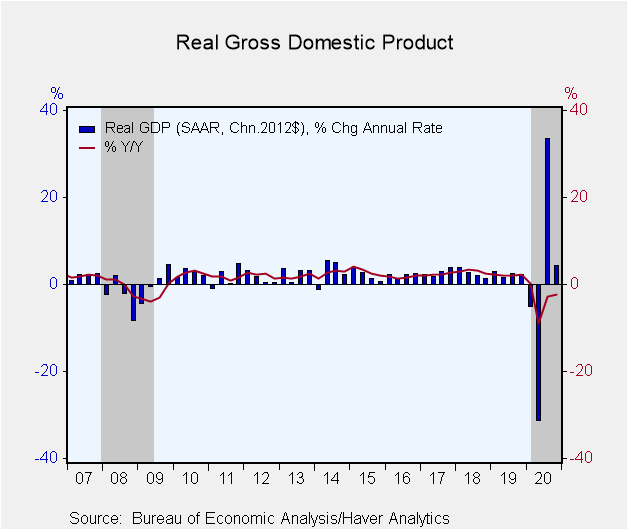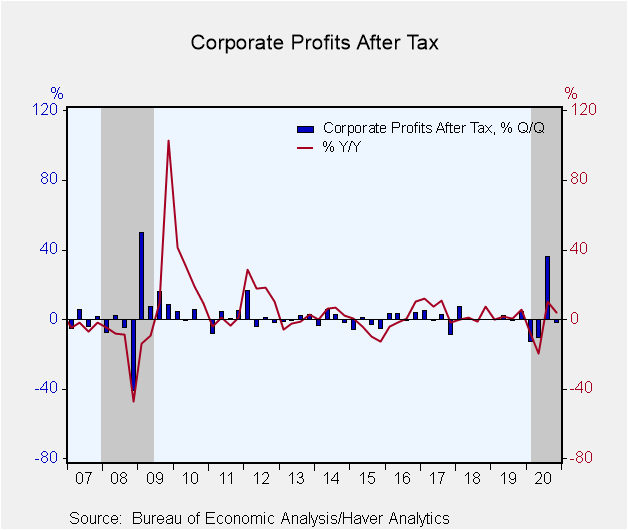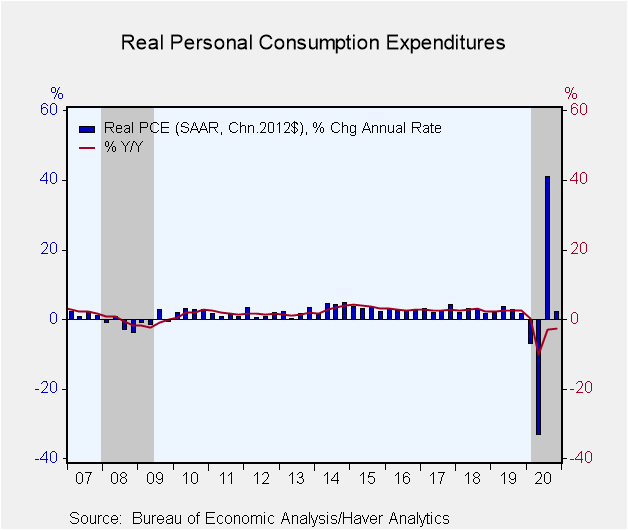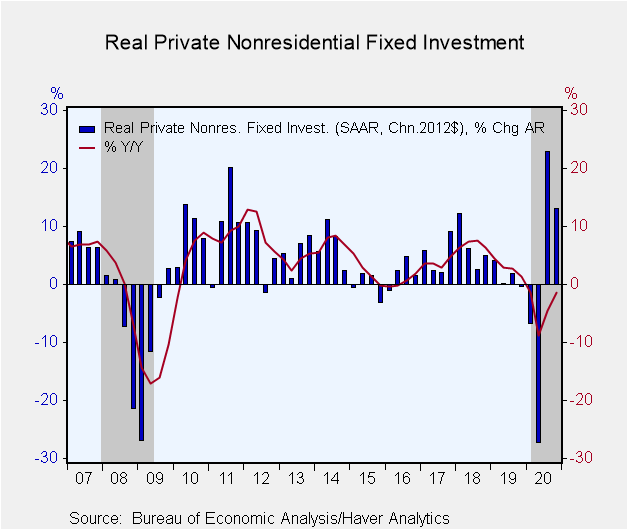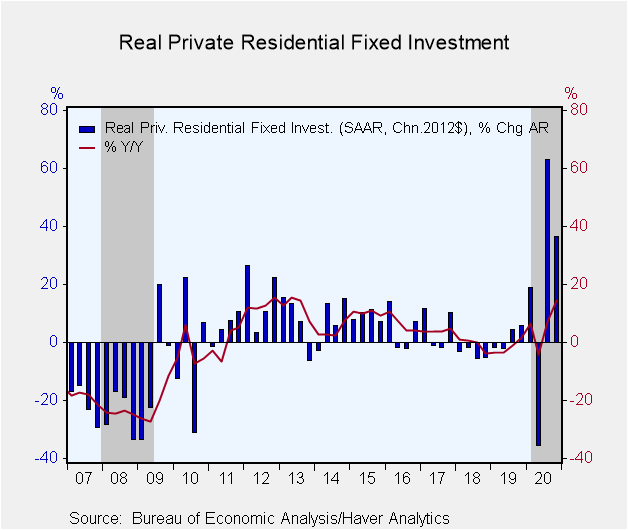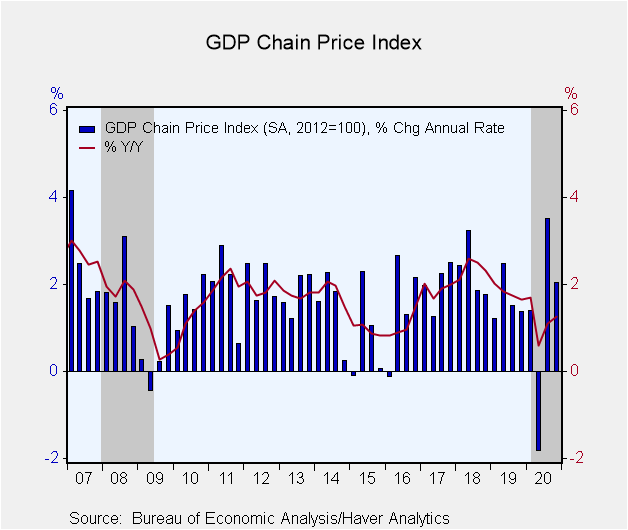 Global| Mar 25 2021
Global| Mar 25 2021U.S. GDP Growth Revised Higher in Q4'20; Corporate Profits Decline
by:Tom Moeller
|in:Economy in Brief
Summary
• Activity remains 2.4% below Q4'19 peak. • Corporate earnings drop follows Q3 surge. • Business fixed investment led growth at yearend. Real GDP rose 4.3% (SAAR) during Q4'20 (-2.4% y/y), revised from 4.1%, following a record 33.4% [...]
• Activity remains 2.4% below Q4'19 peak.
• Corporate earnings drop follows Q3 surge.
• Business fixed investment led growth at yearend.
Real GDP rose 4.3% (SAAR) during Q4'20 (-2.4% y/y), revised from 4.1%, following a record 33.4% jump during Q3. Expectations had been for a 4.1% rise in the Action Economics Forecast Survey.
Corporate profits after tax w/o IVA & CCA weakened 1.7% (+4.1 y/y) following a 36.1% jump in Q3. Before tax earnings with IVA & CCA declined 1.4% (-0.7% y/y) as nonfinancial sector profits fell 3.4% (+3.9% y/y) and financial sector earnings surged. Foreign sector earnings eased 0.2% (-16.0% y/y).
Inventory accumulation added 1.4 percentage points to growth last quarter, revised from 1.1, after adding 6.6 points in Q3. Foreign trade deficit deterioration subtracted an unrevised 1.5 percentage points from growth. Exports rose 22.3% (-10.9% y/y) following a 59.6% jump while imports strengthened 29.9% (-0.5% y/y) after surging 93.0%.
Domestic final sales increased an unrevised 4.4% (-1.5% y/y) following a 29.8% Q3 gain. Consumer spending rose a lessened 2.3% (-2.7% y/y) following a 41.0% Q3 rise. Durable goods spending eased 1.1% (+11.6% y/y) after gaining 82.7% in Q3. Nondurable goods spending fell 1.6% (+4.1% y/y) following a 31.1% gain. Outlays on services increased 4.3% (-6.8% y/y) following a 38.0% Q3 rise.
Business fixed investment grew 13.1% (-1.4% y/y), revised from 14.0% following a 22.9% jump which followed three quarters of decline. Investment in structures fell 6.2% (-16.1% y/y), the fifth consecutive quarterly decline. Equipment investment surged by one-quarter (3.5% y/y) after rising slightly more than two-thirds in Q3.
Residential investment increased by an upwardly revised 36.6% (14.3% y/y) following a roughly two-thirds increase in Q3.
The 0.8% decline (-0.5% y/y) in government spending last quarter compared to a 1.1% decline reported last month. It followed a 4.8% Q3 drop. State and local government spending fell 0.8% (-2.3% y/y), the third consecutive quarterly shortfall. A 0.9% easing in federal government spending (+2.4% y/y) followed a 6.2% Q3 decline.
The expected 2.1% increase (1.3% y/y) in the GDP price index was unrevised as it followed a 3.5% gain during Q3. The PCE price index rose 1.6% (1.2% y/y), roughly half the Q3 increase. The price index less food & energy was also unrevised at 1.4%, both q/q and y/y, easing from 3.4% in Q3. The business fixed investment price index posted a second straight 0.1% rise (0.5% y/y). The residential investment price index strengthened 6.9% (4.9% y/y) after rising 9.5% in Q3. The government sector price index rose an unrevised 2.8% (1.3% y/y), about as it did in Q3.
The GDP figures can be found in Haver's USECON and USNA database. USNA contains virtually all of the Bureau of Economic Analysis' detail in the national accounts. Both databases include tables of the newly published not seasonally adjusted data. The Action Economics consensus estimates can be found in AS1REPNA.
| Chained 2012 $ (%, AR) | Q4'20 (3rd Estimate) | Q4'20 (2nd Estimate) | Q4'20 (1st Estimate) | Q3'20 | Q2'20 | Q4'20 Y/Y | 2020 | 2019 | 2018 |
|---|---|---|---|---|---|---|---|---|---|
| Gross Domestic Product | 4.3 | 4.1 | 4.0 | 33.4 | -31.4 | -2.4 | -3.5 | 2.2 | 3.0 |
| Inventory Effect (%-point) | 1.4 | 1.1 | 1.0 | 6.6 | -3.5 | -0.3 | -0.3 | 0.0 | 0.2 |
| Final Sales | 2.9 | 3.0 | 3.0 | 25.9 | -28.1 | -2.7 | -2.9 | 2.2 | 2.8 |
| Foreign Trade Effect (%-point) | -1.5 | -1.5 | -1.5 | -3.2 | 0.6 | -1.2 | -0.2 | -0.1 | -0.2 |
| Domestic Final Sales | 4.4 | 4.4 | 4.4 | 29.8 | -27.1 | -1.5 | -2.7 | 2.3 | 3.0 |
| Demand Components | |||||||||
| Personal Consumption Expenditure | 2.3 | 2.4 | 2.5 | 41.0 | -33.2 | -2.7 | -3.9 | 2.5 | 2.7 |
| Nonresidential Fixed Investment | 13.1 | 14.0 | 13.8 | 22.9 | -27.2 | -1.4 | -3.7 | 2.5 | 6.9 |
| Residential Investment | 36.6 | 35.8 | 33.5 | 63.0 | -35.5 | 14.3 | 6.1 | -1.7 | -0.6 |
| Government Spending | -0.8 | -1.1 | -1.2 | -4.8 | 2.5 | -0.5 | 1.1 | 2.3 | 1.8 |
| Chain-Type Price Index | |||||||||
| GDP | 2.1 | 2.1 | 2.0 | 3.5 | -1.8 | 1.3 | 1.2 | 1.8 | 2.4 |
| Personal Consumption Expenditure | 1.6 | 1.6 | 1.5 | 3.7 | -1.6 | 1.2 | 1.2 | 1.5 | 2.1 |
| Less Food & Energy | 1.4 | 1.4 | 1.4 | 3.4 | -0.8 | 1.4 | 2.4 | 1.7 | 2.0 |
| Nonresidential Investment | 0.1 | 0.1 | 0.4 | 0.1 | 0.8 | 0.5 | 0.5 | 1.3 | 0.9 |
| Residential Investment | 6.9 | 6.9 | 6.0 | 9.5 | 1.0 | 4.9 | 3.3 | 2.8 | 5.6 |
Tom Moeller
AuthorMore in Author Profile »Prior to joining Haver Analytics in 2000, Mr. Moeller worked as the Economist at Chancellor Capital Management from 1985 to 1999. There, he developed comprehensive economic forecasts and interpreted economic data for equity and fixed income portfolio managers. Also at Chancellor, Mr. Moeller worked as an equity analyst and was responsible for researching and rating companies in the economically sensitive automobile and housing industries for investment in Chancellor’s equity portfolio. Prior to joining Chancellor, Mr. Moeller was an Economist at Citibank from 1979 to 1984. He also analyzed pricing behavior in the metals industry for the Council on Wage and Price Stability in Washington, D.C. In 1999, Mr. Moeller received the award for most accurate forecast from the Forecasters' Club of New York. From 1990 to 1992 he was President of the New York Association for Business Economists. Mr. Moeller earned an M.B.A. in Finance from Fordham University, where he graduated in 1987. He holds a Bachelor of Arts in Economics from George Washington University.


